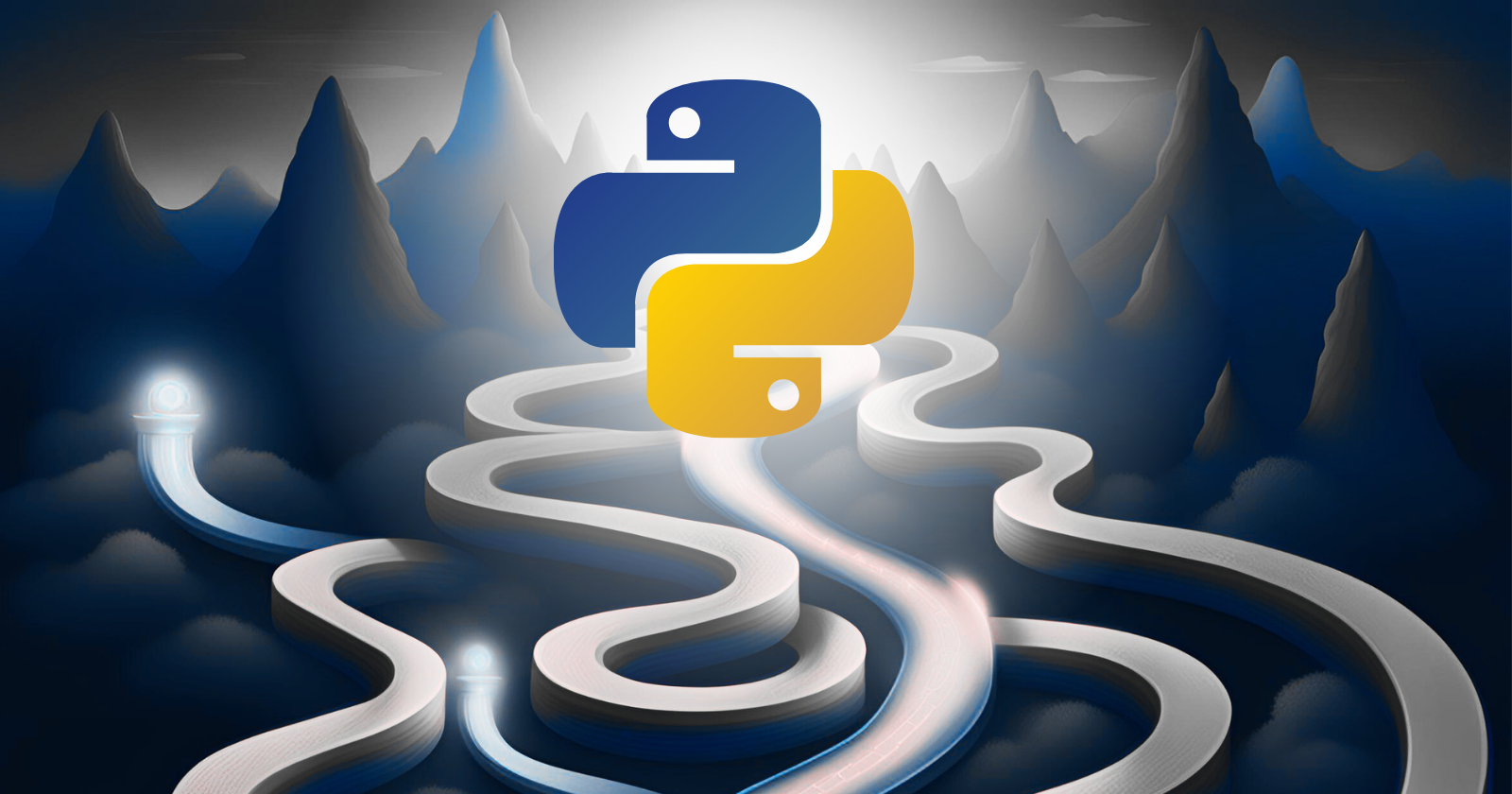All Roads Lead to Python
 Hugo Tavares
Hugo Tavares
Python is a popular and versatile programming language known for its simplicity and powerful libraries. It's ideal for beginners and professionals alike, offering a wide range of applications from web development (using Django and Flask) to data science (with Pandas and Matplotlib), AI and machine learning (using TensorFlow), and automation. Python's active community and abundant resources make it a valuable skill to learn, opening doors in various fields such as game development, computer graphics, and desktop applications. This article explores why Python stands out and the diverse paths you can follow by mastering it.
Introduction 🔌
Python is one of the most popular and versatile programming languages available today. Its simplicity, combined with a powerful range of libraries and frameworks, makes it an ideal choice for both beginners and experienced professionals. In this article, we'll explore the main aspects that make Python such an attractive language and the various paths you can follow by mastering it.
Why Python Stands Out 😉
Ease of Learning
Python is often recommended as the first programming language for beginners. Its simple and readable syntax makes it easy to understand basic programming concepts without the added complexity of other languages. For example, compare a simple "Hello, World!" in Python with C++:
Python:
print("Hello, World!")
C++:
#include <iostream>
int main() {
std::cout << "Hello, World!" << std::endl;
return 0;
}
The difference is clear. Python allows beginners to focus on logic and problem-solving, rather than getting lost in syntax details.
Community and Support
Python has a vibrant and active community. This means there is an abundance of resources available, from tutorials and documentation to discussion forums and support groups. Sites like Stack Overflow and Reddit have dedicated communities to help Python programmers of all levels.
Versatility
One of Python's greatest advantages is its versatility. It is used in a wide variety of applications, from web development to data science, artificial intelligence, and automation. This means that learning Python can open doors in many different fields.
Paths You Can Follow with Python 🛣️
Web Development
Python is widely used in web development, thanks to frameworks like Django and Flask. Django is a high-level framework that promotes rapid development and clean, pragmatic design. Flask, on the other hand, is a microframework that offers more flexibility for developing custom web applications.
Example with Django:
# mysite/urls.py
from django.contrib import admin
from django.urls import path
from . import views
urlpatterns = [
path('admin/', admin.site.urls),
path('hello/', views.hello_world),
]
# mysite/views.py
from django.http import HttpResponse
def hello_world(request):
return HttpResponse("Hello, World!")
With Django, you can quickly set up a project and create routes and views that facilitate the development of robust web applications.
Example with Flask:
from flask import Flask
app = Flask(__name__)
@app.route('/')
def hello_world():
return 'Hello, World!'
if __name__ == '__main__':
app.run()
Flask offers a more minimalist and flexible approach, ideal for smaller projects or when you want more control over the components used.
Data Science
Python has become the preferred language for data science due to its powerful libraries, such as Pandas, NumPy, and Matplotlib. With these tools, you can perform data analysis, visualization, and even machine learning with libraries like Scikit-learn and TensorFlow.
Example with Pandas:
import pandas as pd
data = {'Name': ['Alice', 'Bob', 'Charlie'], 'Age': [24, 27, 22]}
df = pd.DataFrame(data)
print(df)
Pandas allows efficient and intuitive data manipulation, making complex data analysis tasks much simpler.
Example with Matplotlib:
import matplotlib.pyplot as plt
x = [1, 2, 3, 4, 5]
y = [2, 3, 5, 7, 11]
plt.plot(x, y)
plt.xlabel('x values')
plt.ylabel('y values')
plt.title('Simple Line Plot')
plt.show()
Matplotlib makes it easy to create graphs and visualizations, allowing you to turn your data into visual insights.
Artificial Intelligence and Machine Learning
In the field of AI and Machine Learning, Python stands out with libraries like TensorFlow, Keras, and PyTorch. These libraries make it easy to build and train complex AI models. Additionally, Python has a vast ecosystem of tools for working with big data, such as Apache Spark and Dask.
Example with TensorFlow:
import tensorflow as tf
# Building a simple neural network model
model = tf.keras.models.Sequential([
tf.keras.layers.Dense(128, activation='relu'),
tf.keras.layers.Dense(10, activation='softmax')
])
# Compiling the model
model.compile(optimizer='adam', loss='sparse_categorical_crossentropy', metrics=['accuracy'])
# Training the model with dummy data
model.fit(x_train, y_train, epochs=5)
TensorFlow allows the creation and training of machine learning models with just a few lines of code.
Automation and Scripting
Python is an excellent choice for automation and scripting. If you need to automate repetitive tasks, such as file manipulation or interactions with APIs, Python can help simplify these processes with libraries like os.path, shutil, and requests.
Example with Requests:
import requests
response = requests.get('https://api.github.com')
if response.status_code == 200:
print('Success:', response.json())
else:
print('Failed:', response.status_code)
The Requests library makes it easy to send HTTP requests, allowing you to interact with APIs simply and effectively.
Other Applications
In addition to the areas already mentioned, Python is also used in fields such as game development (with Pygame), computer graphics (with Blender), and desktop application development (with Tkinter or PyQt).
Example with Pygame:
import pygame
pygame.init()
screen = pygame.display.set_mode((640, 480))
running = True
while running:
for event in pygame.event.get():
if event.type == pygame.QUIT:
running = False
screen.fill((0, 0, 0))
pygame.display.flip()
pygame.quit()
Pygame allows the creation of interactive games and simulations, making it a popular choice among indie game developers.
Tips for Learning Python from Scratch 👨🏻💻
Sites for Beginners 👣
Codecademy - Offers an interactive course for Python beginners.
Coursera - The University of Michigan offers a popular Python course for all levels.
SoloLearn - A great mobile app to learn Python and other languages on the go.
Python.org - The official Python website has excellent documentation and tutorials for beginners.
Microsoft Learn - Offers various learning paths related to Python.
Sites to Improve or Test Your Knowledge 🔥
LeetCode - A platform to practice coding problems and prepare for technical interviews.
HackerRank - Offers Python programming challenges to sharpen your skills.
Real Python - Advanced resources and tutorials on various aspects of Python.
Project Euler - Mathematical and programming challenges to improve your problem-solving skills.
Conclusion ✅
Python is a language that can lead you to many different paths in programming and technology. Whether in web development, data science, artificial intelligence, or automation, learning Python is an investment that pays off. With a robust support community and a vast amount of learning resources, you are one step away from becoming proficient in one of the world's most powerful and versatile programming languages. Start today, explore the different paths, and see where Python can take you!
Subscribe to my newsletter
Read articles from Hugo Tavares directly inside your inbox. Subscribe to the newsletter, and don't miss out.
Written by

Hugo Tavares
Hugo Tavares
Hello World, my name is Hugo. I’m a Christian, husband, and father. I hold a degree in Administration and have experience in the military as an air traffic controller. Additionally, I’m a frontend developer, fascinated by technology, and constantly seeking to learn new things.